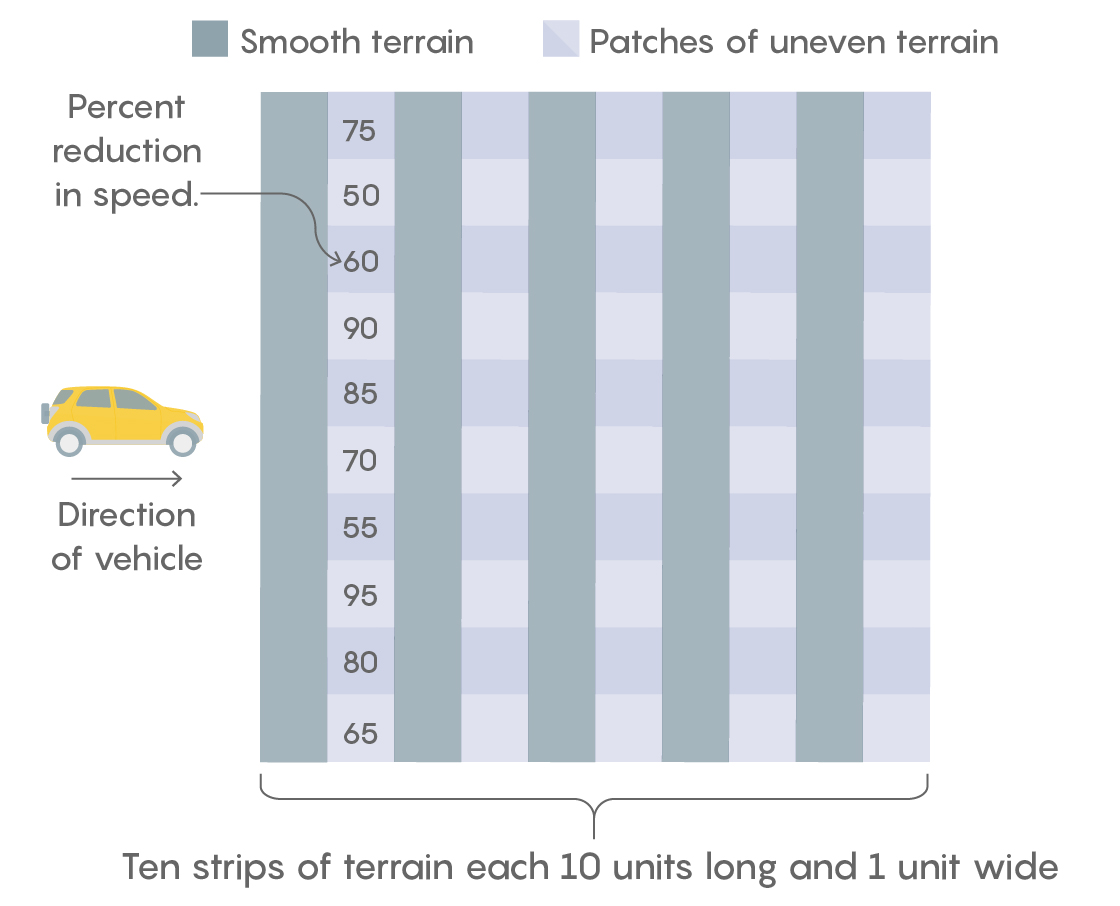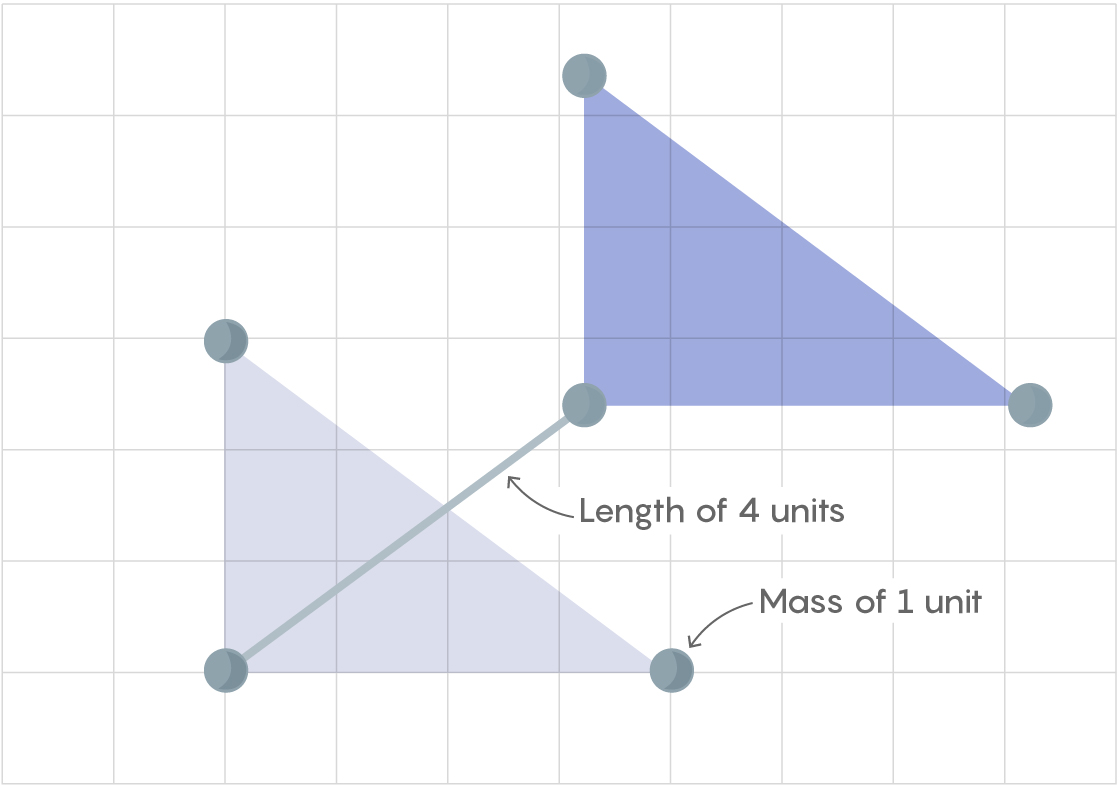Solution: ‘Natural Law and Elegant Math’

Dan Page for Quanta Magazine
Introduction
Ever since Pythagoras, many have believed in the special power of beautiful mathematics in helping to lay bare the secrets of the world. In last month’s Insights puzzle, we used Eugene Wigner’s famous article “The Unreasonable Effectiveness of Mathematics in the Natural Sciences” to launch a discussion on this topic and solve some related puzzle scenarios. Quanta readers responded enthusiastically to both the puzzles and the topic, filling the comments section with thoughtful solutions and insights, which we discuss below.
The puzzles were intended to show that while mathematics is definitely very useful in creating idealized models and elegant explanations of many physical phenomena, real-world situations often require us to scramble through dense numerical thickets.
Scenario 1: Simplicity and Uniformity
A. An object slides on a uniform surface with initial velocity 1. For every 1 unit of distance, its velocity decreases by 1/10 of what it was at the start of that particular unit. How far will the object travel before it stops? What’s the general formula?
This is a somewhat tricky problem. It is superficially reminiscent of Zeno’s paradox about Achilles and the tortoise, which yields infinite geometric series such as 1 + 1/2 + 1/4 + 1/8… in both time and distance. Even though these series are infinite, they converge and therefore have a finite sum (in this case 2). So a finite distance is covered in finite time in the Zeno case. However, in our problem, velocity alone is decreasing in proportion to its own value for every constant unit of distance. This property, where the change in value of a variable (its derivative) is proportional to itself for a unit change in an independent variable, is characteristic of an exponential curve. The value of a variable that undergoes exponential decay approaches zero but never reaches it. Thus, for every unit of distance up to infinity, our object will continue to have a finite velocity and will therefore cover the distance in finite time. Hence, by the idealized laws of physics, the object will never stop, as Lionel Lincoln, Ty Rex and Jonathan Vercruysse pointed out. Vercruysse gives the correct distance (D) to time (T) formula, which involves logarithms as would be expected for an exponential curve:
$latex D=\frac{\log \left(\frac{T}{9}+1\right)}{\log \frac{10}{ 9}}$
You can check out Vercruysse’s comment for a more detailed explanation.
So, according to the idealized laws of motion, the object will never stop — it will continue moving at a decreasing snail’s pace forever. Is this really true? Of course not! And here, literally at the place where the rubber meets the road, is where elegant, abstract, continuous, smooth, predictable mathematics meets messy, practical, rough, chaotic, unpredictable reality. The reason the object will stop is that the frictional force that causes the velocity to slow down is created by millions of tiny jagged imperfections of the two surfaces rubbing against each other. Hence at small scales the value of this force varies chaotically even though it may have a steady average value. At very low velocity, some random group of slightly larger-than-average imperfections will be the proverbial last straw that will stop the object dead. As Lionel Lincoln rightly remarked, “Since the velocity is exponentially getting smaller, the speed will never reach 0; however, the velocity will eventually get too small to move the object.” And the precise point at which this will occur is, in practice, unpredictable, even though the process is classically deterministic. Unless, of course, you are willing to spend the rest of the life of the universe modeling the interactions of every small imperfection of the two surfaces on your galaxy-size supercomputer.
Incidentally, this humble situation is analogous to one in a far more important frontier of modern physics, where the smooth, continuous mathematics of general relativity meets the microscopic, probabilistic, chaotic vacuum fluctuations of quantum field theory, in the Planck-scale crucible where space and time are created. Still ambitious enough to attempt this reconciliation? More power to the brave theoreticians who are willing to attempt it!
B. A powered vehicle can move forward or sideways with equal ease. Its normal cruising velocity in either direction is 1 unit on smooth ground. As shown in the figure, it has to navigate through 10 strips of terrain each 10 units long and 1 unit wide. The long axis of each strip is perpendicular to the direction that the vehicle needs to go. The vehicle is sitting near the middle of the first strip, which is smooth (shown gray in the figure). Thereafter uneven (purple) strips and smooth strips alternate.

The uneven strips are not uniformly uneven, but consist of 10 square patches that we can think of as “speed bumps.” The speed bumps are stacked one on top of another, and each one is 1 unit by 1 unit in size. The speed bumps vary in how uneven they are. A speed bump can cause the vehicle’s cruising velocity to be reduced by any amount from 50% to 95% in 5% increments. All 10 types of speed bumps are present in every uneven strip, in a random arrangement (one possible arrangement of speed bumps is shown in the first purple strip in the figure). The vehicle can sense the roughness of the speed bump directly ahead of it and can move sideways at its cruising velocity of 1 in order to traverse a different speed bump that will slow it down less, if it so chooses. Of course, this will cost it time, and the time penalty will be greater if it moves sideways multiple blocks. After each strip, the cruising velocity returns to 1 on the intervening smooth strip. What strategy should the vehicle adopt to cross the terrain as fast as possible? How long will this be expected to take?
(For those who asked about “speed bump lookahead” or “foresight,” note that it is clearly stated in the original problem that the vehicle can sense the roughness of the speed bump directly ahead of it — yes, only that one!)
This problem was solved wonderfully well by Jonathan Vercruysse. Vercruysse first clearly listed the amount of time it takes to cross every type of speed bump in a single strip. In increasing order, these times are: 2, 2.22, 2.5, 2.86, 3.33, 4, 5, 6.67, 10 and 20 units. The penalty for moving one place sideways is 1 unit. As you can see, there is a difference greater than 1 between the 85% speed bump and the one before it; the same is true of the 90% and 95% speed bumps. So it’s a no-brainer that you should move sideways when you encounter any of these three. The 80% speed bump is on the borderline — it takes exactly 1 unit longer to traverse than the 75% speed bump. But if you’re optimistic, you can move sideways with a very good chance of encountering one of the speed bumps that are quite a bit more than 1 unit faster. On the other hand, you might have the misfortune to encounter the three slowest speed bumps one after another after that, increasing your time somewhat, though the probability of this is quite low. Since there are 10 speed bumps in every strip, there will always be at least five speed bumps either to your left or to your right, no matter where you are when you arrive at an uneven strip. You should always choose the side with five or more when you move sideways. Thus, even in the worst-case scenario, you are still guaranteed to eventually find a faster speed bump when you’re trying to avoid the 80% one, so that you can still return a reasonable time for the strip. In most cases you will do better, sometimes much more so.
So which is better, avoiding the 85% bump and going with the 80%, or avoiding the 80%, or perhaps even avoiding the 75%? Unfortunately, there is no shortcut. You have to get into the weeds and calculate the probabilities and the times for about 30 possible cases to get the average time for a single strategy. Vercruysse calculated this for all 10 possible strategies, and the winning strategy is: “Avoid the 80 but go with the 75 or lower!” The average time to traverse a single bumpy strip for this strategy is 3.39 units, giving a total time to traverse the entire terrain of 21.95 units. You can find more details in Vercruysse’s comment.
Coming back to the theme of this puzzle, I just want to note that the initial framing of the problem needs some elegant mathematical thinking, but after that you have to get your hands dirty.
Scenario 2: Summation and Symmetry
Consider a hypothetical rigid object that is shaped like a right triangle with virtually all of its mass concentrated at its vertices. For simplicity, imagine that the object is entirely two-dimensional — it has no thickness. Each vertex is a point mass of 1 unit, and the total mass is 3 units. The triangle has a base 4 units long, a vertical side 3 units long and a hypotenuse 5 units long going from upper left to lower right. Imagine there is a second such triangle in the same orientation, located as shown, such that the medians (lines drawn from the midpoint of the hypotenuse to the opposite vertex) of the two triangles lie on the same straight line, with the corresponding right-angle vertices 4 units apart. What would the magnitude of the gravitational force be? Does the law of gravitational attraction work if you try to apply it between the two triangles as individual objects? What if the triangles were 8 units apart in the same orientation? Does the formula for gravitational attraction work better if applied to the individual triangles now?

Solving this one requires calculating all nine gravitational interactions between the three masses of one triangle and the three masses of the other, and adding all nine vectors together to get the result. Then you compare that to the gravitational attraction that would have happened if the entire 3-unit mass of each triangle were concentrated at its center of mass, the two centers of mass being 4 units apart. For vector addition you can use one of the many available online vector addition calculators, or you can use a math program like Maple, the approach followed by Staffan Söderhjelm, who provided the correct solution. The usual Newtonian formula gives a magnitude of gravitational attraction that is only 68.3% of the actual value obtained by adding the nine attraction vectors. When the distance is doubled to 8 units, this rises to 94.3%. So the simplified Newtonian center-of-mass formula very soon becomes quite accurate.
Of course, as Ty Rex explained in full technical detail, at close range there will be tidal forces and torque exerted on the triangles, and their motion will be quite complex and unstable. Thank you for the chapter and verse, Ty!
So does natural law require elegant mathematics? Quanta readers made many interesting points about this and related issues. I’ve described or excerpted (with some light edits) some of these based on the question they address.
What makes elegant mathematics powerful and widely applicable?
Ty Rex lovingly listed the factors that make elegant mathematics powerful and capable of giving pretty accurate results even with a single widely applicable formula, specifically mentioning continuity, infinity, bootstrapping and symmetry.
John Takao Collier offered the following anecdote:
A few weeks ago I had a discussion with Don Lincoln, a physicist at Fermilab. My question to Don was “Why [does] mathematics describe the Universe so well?” Don replied that there are … infinite ways in which mathematical systems can be formulated, so if you have a causal Universe, you’ll always be able to find a mathematical framework within that infinite set and that describes physics.
Several other readers made similar observations. It seems to me that mathematics itself is a vast collection of patterns and techniques, which by their very abstract nature can find application in many unrelated areas with the same structure and dynamic or other reciprocal interactions. Also, as some readers remarked, we are lucky to be living in a universe where elegant mathematics is useful. As Ed Zielinski remarks, “Mathematics and Newton’s law for example, would be pretty impractical if we lived in a universe of near maximum entropy.”
But how far can elegant mathematics go in describing nature?
Madeleine Birchfield gave a strong and much-appreciated response, which I quote in full:
You do not even need to go into biology to find that many mathematical representations becoming insufficient: chemistry, materials science, and condensed matter physics are sufficient. For example, a water molecule is impossible to solve analytically using the tools of quantum mechanics, for the same reason that the three-body problem is intractable in celestial mechanics. The entire field of thermodynamics and statistical mechanics occurs because physical systems such as an ice cube in a bath of water are too complex to represent mathematically for every single water molecule in both the ice cube and the bath, let alone Bose-Einstein condensates (reliant upon Bose-Einstein statistics) or superfluidity. Ohm’s Law is an electromagnetic version of a crude statistical summary, and Hooke’s Law and the stress/strain tensors are elastic versions of crude statistical summaries, both of which fail at a certain time or limit due to the temperature and material dependence of current flow in electrical wires and the effects of permanent deformation in physical bodies at high stresses and strains.
In fact, the reason why the vast majority of the maths in the domain of physics is simple is precisely because it is a crude statistical summary or a gross simplification of the physical phenomena.
Well said, Madeleine. Our love for math shouldn’t blind us to these truths!
What makes us appreciate elegant math?
I think DH nailed it with a post titled “Lower brain energy cost of simplicity = elegance?” The key passage is below:
The feeling of EUREKA, the brain’s reduction of high complexity to a single, neuron-organizing principle or ‘mathematical law’ for many problems, is an example of simplification that leads to this euphoric (endorphic?) energy-saving feeling. This explanation may relate to the KISS (Keep It Simple Stupid) principle, as well as Einstein’s quote regarding “Everything should be made as simple as possible, but no simpler.”
The brain’s recognition that nature exhibits many phenomena that are related to each other is just such symmetry that our neurons’ self-organization behavior perceives as low-energy storage solutions.
As I argue in my Math Horizons article on the subject, both Occam’s razor and the highs of the “aha!” or “eureka!” feeling are hard-wired into our brains and are manifestations of the unique cognitive-emotional link that makes us the intelligent creatures we are. I conjecture that whenever a quantity I call “psychic entropy” suddenly decreases in our minds, we get an intrinsic reward. This psychic entropy is not just compactness but also organization, hitherto unseen connections, and the sense of things fitting together without loose ends. Evolution has made us cognitive beings by giving us small internal rewards whenever we solve a puzzle — a very effective strategy.
So was Wigner right?
Yes and no. He was right that elegant mathematics involving abstract patterns and symmetry works for some of physics, and when it does, it is very powerful. However, there are areas in physics, and many more in other complex sciences, where this is not true. Perhaps Wigner was a bit of a mystic, or a “patriot of mathematics,” as a couple of readers suggested, and somewhat overstated the case.
Thank you for the great discussion, everyone! The puzzle prize goes to Jonathan Vercruysse. Congratulations and see you soon for more Insights!



